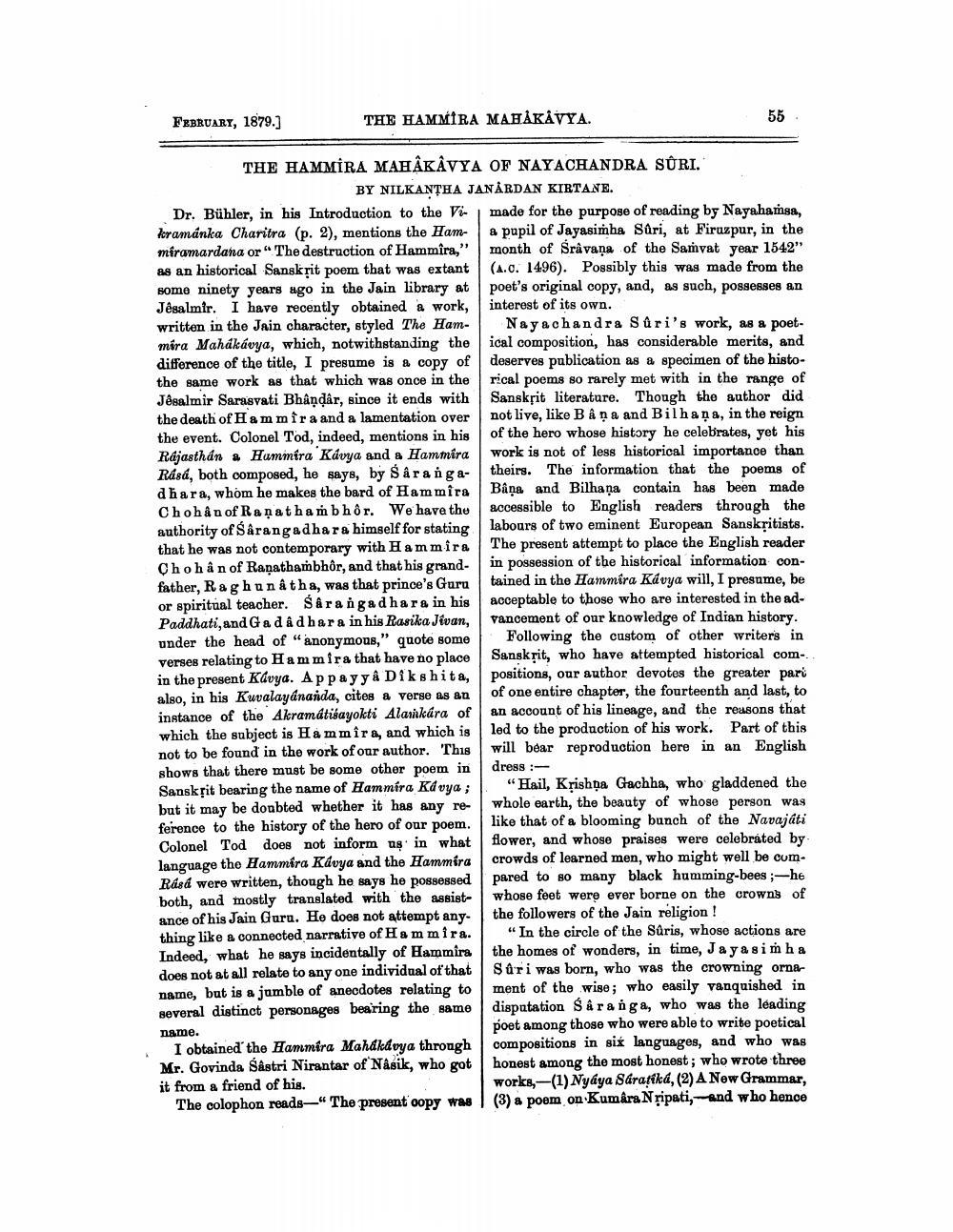________________
FEBRUARY, 1879.]
THE HAMMIRA MAHÅKÅVYA.
55
THE HAMMİRA MAHAKAVYA OF NAYACHANDRA SORI.
BY NILKANTHA JANÅRDAN KIRTANE. Dr. Bühler, in his Introduction to the Vi- made for the purpose of reading by Nayahamsa, kramánka Charitra (p. 2), mentions the Ham- & pupil of Jayasimha Sûri, at Firuzpur, in the miramardana or "The destruction of Hammîra," month of Sråvaņa of the Samvat year 1542" as an historical Sanskrit poem that was extant (a.c. 1496). Possibly this was made from the some ninety years ago in the Jain library at poet's original copy, and, as such, possesses an Jêsalmir. I have recently obtained & work, interest of its own. written in the Jain character, styled The Ham- Nayachandra Sari's work, as a poetmira Mahákávya, which, notwithstanding the ical composition, has considerable merits, and difference of the title, I presume is a copy of deserves publication as a specimen of the histothe same work as that which was once in the rical poems so rarely met with in the range of Jêsalmir Sarasvati Bhändår, since it ends with Sanskrit literature. Though the author did the death of Hammira and a lamentation over not live, like B âņa and Bilhana, in the reign the event. Colonel Tod, indeed, mentions in his of the hero whose history he celebrates, yet his Rajasthan * Hammira Kávya and a Hammira work is not of less historical importance than Rasd, both composed, he says, by Saranga- theirs. The information that the poems of dhara, whom he makes the bard of Hammira Bâņa and Bilhaņa contain has been made Chohâ n of Ranathambhôr. We have the accessible to English readers through the authority of Sarangadhara himself for stating labours of two eminent European Sanskritists. that he was not contemporary with H ammira The present attempt to place the English reader Choh â n of Ranathambhôr, and that his grand- in possession of the historical information confather, Raghunatha, was that prince's Guru
tained in the Hammira Kávya will, I presume, be or spiritual teacher. Sarangadhara in his acceptable to those who are interested in the adPaddhati and Gadadhara in his Rasika Jivan, vancement of our knowledge of Indian history. under the head of "anonymous," quote some | Following the custom of other writers in verses relating to Hammira that have no place Sanskrit, who have attempted historical com.. in the present Kavya. Appayya Dikshita, positions, our author devotes the greater pari also, in his Kuvalayananda, cites a verse as an of one entire chapter, the fourteenth and last, to instance of the Akramátisayokti Alarikára of an account of his lineage, and the reasons that which the subject is Hammira, and which is led to the production of his work. Part of this not to be found in the work of our author. This will bear reproduction here in an English shows that there must be some other poem in dress : Sanskrit bearing the name of Hammíra Ka vya; "Hail, Krishga Gachha, who gladdened the but it may be doubted whether it has any re- whole earth, the beauty of whose person was ference to the history of the hero of our poem. like that of a blooming bunch of the Navajati Colonel Tod does not inform us in what flower, and whose praises were celebrated by language the Hammíra Kávya and the Hammira crowds of learned men, who might well be oumRásd were written, though he says he possessed pared to so many black humming-bees ;-he both, and mostly translated with the assist- whose feet were ever borne on the crowns of ance of his Jain Guru. He does not attempt any the followers of the Jain religion ! thing like a connected narrative of Hammira. "In the circle of the Súris, whose actions are Indeed, what he says incidentally of Hammira the homes of wonders, in time, Jayasinha does not at all relate to any one individual of that Sûri was born, who was the crowning orna name, but is a jumble of anecdotes relating to ment of the wise; who easily vanquished in several distinct personages bearing the same disputation Saranga, who was the leading name.
poet among those who were able to write poetical I obtained the Hammira Mahdkdvya through compositions in six languages, and who was Mr. Govinda Sastri Nirantar of Násik, who got honest among the most honest; who wrote three it from a friend of his.
works, ---(1) Nyaya Sáratiká, (2) A New Grammar, The colophon reads—“ The present oopy was (3) a poem on Kumâra Nripati, -and who hence




